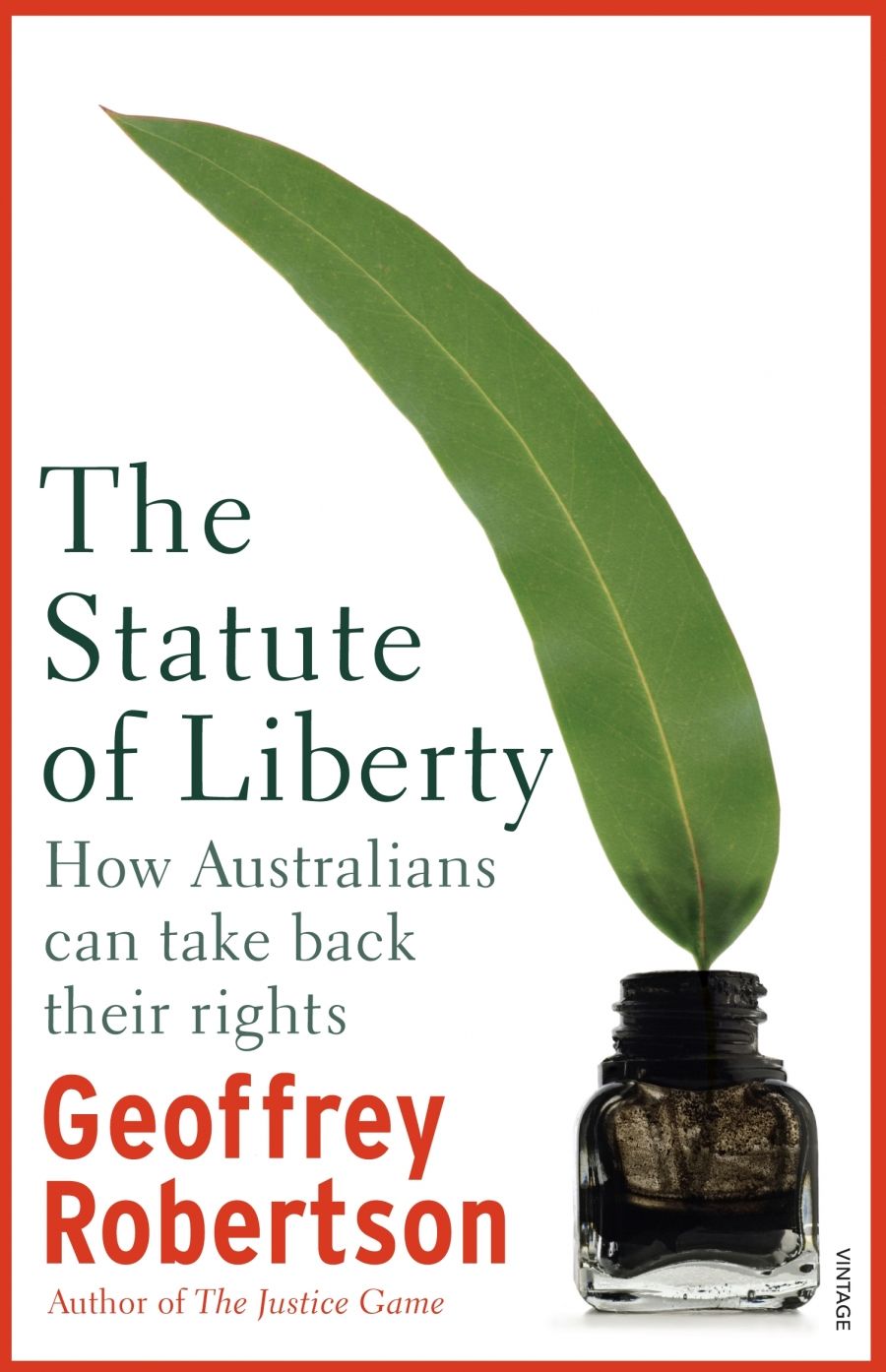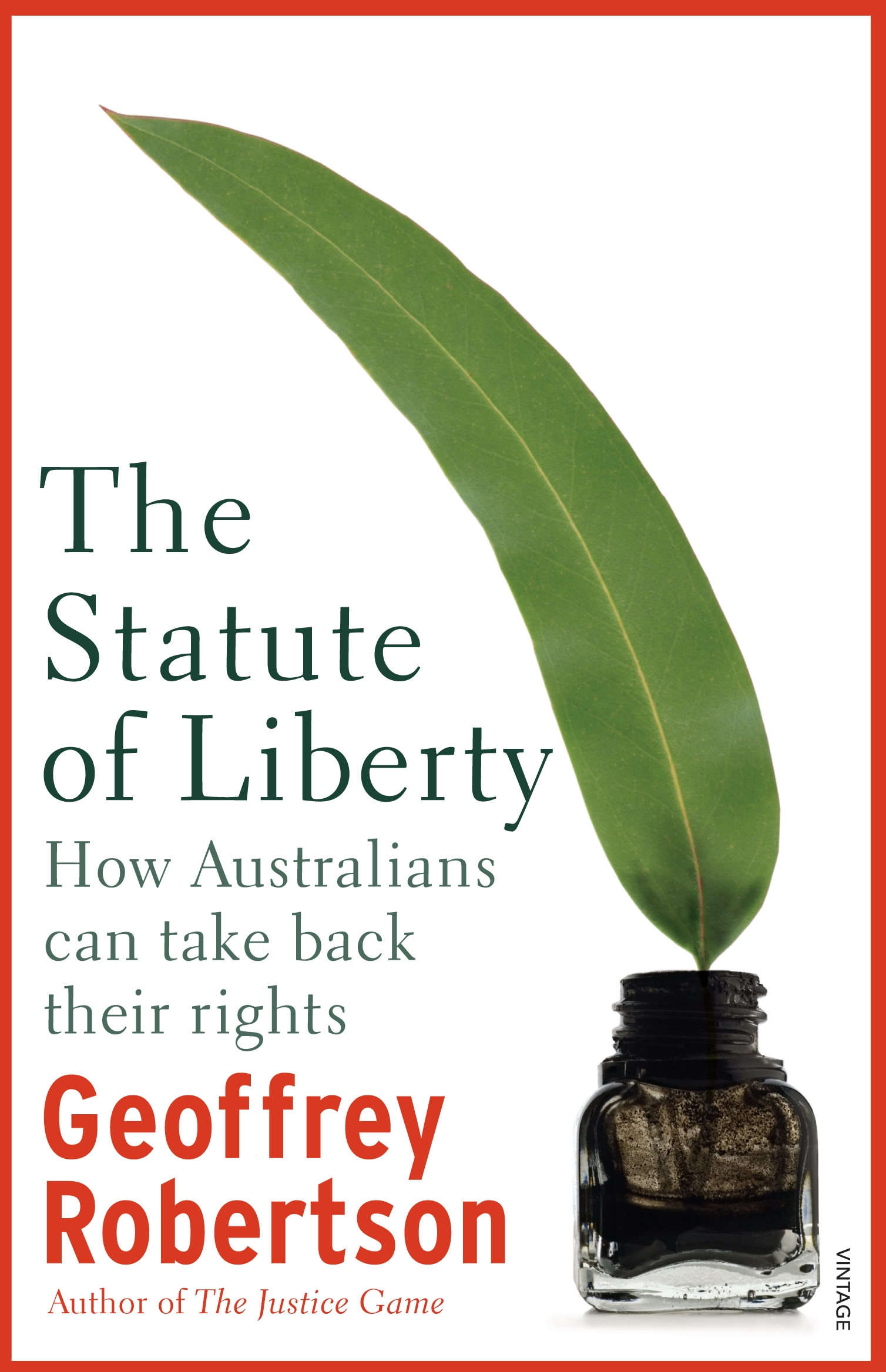
- Free Article: No
- Contents Category: Politics
- Review Article: Yes
- Article Title: Beetroot on my hamburger
- Online Only: No
- Custom Highlight Text:
In characteristically symbolic fashion, the Rudd government chose the sixtieth anniversary of the Universal Declaration of Human Rights (10 December 2008) to announce a consultation process into human rights protection in Australia. Attorney-General Robert McClelland appointed a committee, headed by Jesuit priest and lawyer Frank Brennan, to consult the public on issues including whether Australia needs a bill (or charter) of rights and responsibilities. Geoffrey Robertson’s latest book, The Statute of Liberty: How Australians Can Take Back Their Rights, injects much-needed energy, imagination, and international context into this rather circumscribed debate. ‘I have spent my professional life making arguments based on bills of rights,’ says Robertson. As a distinguished and courageous human rights lawyer-activist, his emphatically pro-charter stance commands the thoughtful consideration of supporters, opponents, and equivocators alike.
- Book 1 Title: The Statue of Liberty
- Book 1 Subtitle: How Australians Can Take Back Their Rights
- Book 1 Biblio: Vintage, $19.95 pb, 244 pp, 9781741666823
- Book 1 Cover Small (400 x 600):

- Book 1 Cover (800 x 1200):

Robertson has argued for many years that a bill of rights is the missing link in Anglo-Australian common law (that is, judge-made law), vital in providing individuals with protection against the misuse of power by the state. Given that Australia inherited its ‘patchwork’ common law from Britain, it is striking that the United Kingdom, via the Human Rights Act 1998, has now made the European Convention of Human Rights a part of its law. Robertson labels as absurd the proposition that a bill of rights transfers too much power from elected politicians to unelected judges: ‘The separation of powers at the heart of any true democracy entrusts policy to parliament, and its fair and efficient implementation to a judiciary strictly independent of government.’ He is not the first commentator to point out that Australia is the only ‘advanced’ democracy without a bill of rights (although Victoria and the ACT both have charters), but his infectious optimism in the law acts as a counter to the great and destructive Australian sport of lawyer-bashing.
When people imagine a bill of rights, they often think of the United States, where rights are embedded in the constitution. But the Rudd government has explicitly rejected this model: any Australian bill of rights will come via a statutory model, with rights codified in legislation which parliament can amend or repeal. Robertson praises the United States as the ‘purest form of democracy’ and labels the statutory model a ‘halfway house between constitutional protection of liberty and no protection at all’. While bemoaning the Rudd government’s minimalist mindset, he somewhat begrudgingly endorses the statutory model.
When Robertson turns his attention to the question of ‘What rights?’ his discussion becomes particularly thought-provoking. He argues that some rights – for instance, the right to ‘life, liberty and security of person’ (Article 3 of the Universal Declaration) – should be absolute. But a myriad of civil, political, economic, social, and cultural rights are aspirational, or subject to the competing rights of other individuals, or can be overridden by, say, the national interest. Whereas some people might fear a legal quagmire, and while others might wince at the prospect of ‘core’ and ‘non-core’ rights, Robertson is thrilled at the thought of the law determining outstanding issues based on first principles rather than old precedents. He acknowledges that ‘Critics have a point when they describe the bench as predominantly male, middle-minded and middle-class’, but he counters that judges are trained to apply the spirit of the law. Still, Robertson might have probed more deeply into the complexities of competing rights, perhaps by reflecting more fully on the Haneef case or by examining in greater detail the uneasy relationship between the right to privacy and the right to know.
But what Robertson does do is explicitly link the question ‘What rights?’ with the debate about the nature of Australian identity: ‘We need a statute of liberty with a preamble that children can learn at school and recite with pride; one that will reflect the unique history that has influenced our definition of a free society.’ Robertson marries moments in Australian history to particular human rights. For example, he praises Arthur Phillip for words he wrote in 1787 as the First Fleet prepared to sail: ‘There can be no slavery in a free land and consequently no slaves.’ Robertson writes, ‘Are Australians proud of Phillip’s landmark law? Most have not heard of it ... So much for the pride we have in the potentially iconic moments of our history – they are there for the taking, yet we fail to celebrate them or make them any part of our civic life.’ Robertson commemorates Phillip’s words by turning them into Section I of his draft ‘Charter of Australian Liberty’.
As more examples pile up – the right to ethical scientific experimentation (commemorating Banks and Flinders), the right to free association (the Eureka Stockade), and so on – there’s a whiff of an old Fosters Lager television commercial: ‘I fight wars but never start wars ... I like beetroot on my hamburger.’ But Robertson builds a tangible rationale for a hill of rights that the nation genuinely owns, one that complicates but also complements our ‘She’ll be right, mate’ culture. And by demanding that a bill of rights – and that patriotism – acknowledge Australia’s collective failures, as well as celebrates its successes, he scuppers the stale three cheers/black armband dichotomy. Robertson’s ‘Charter of Australian Liberty’ – he calls it a ‘wet-Sundayafternoon effort’ – is a more expansive and precisely aimed blueprint than Kevin Rudd could probably countenance, which makes it a terrific starting point for debate.
Robertson, with a mix of finely calibrated rebuttals and unconcealed exasperation at the wrong-headedness of it all, rejects the central arguments of anti-bills of rights campaigners: that a charter would undermine parliamentary democracy, or create a lawyer’s picnic and a compensation culture, or unduly favour minorities, or undermine freedom of religion. He lets off steam by labelling columnist Janet Albrechtson’s prose ‘so purple it’s practically puce’. He argues that law academic James Allan’s arguments ‘tend to be summed up in sound bites: “Judges will win; elected legislators will lose”,’ although, mysteriously, he cites Allan’s newspaper articles rather than his academic work. He systematically demolishes what he views as Bob Carr’s alarmist and misinformed critique of the UK Human Rights Act, suggesting that Carr ‘betrays a discomfort with the doctrine of the separation of powers between the executive and the judiciary’. He’s gentler towards the Catholic Archbishop of Sydney, George Pell, describing as ‘misplaced’ his anxiety about the fate of religious liberty under a bill of rights, and adding that ‘[o]n any view, Christ came into the world to succour the poor, the vulnerable, and the despised’.
Again and again, Robertson finds it extraordinary that a statutory bill of rights is politically controversial, and worries that Carr’s anti-charter stance is really an appeal to ‘the political cowardice of his Labor colleagues’. In contrast, Robertson suggests that a republic is ‘inevitable’ and that ‘a more satisfactory settlement with Aboriginal Australians will undoubtedly be worked out’. This seems hopeful, given that the republic debate splutters along in ‘maybe later’ mode, and that Hawke-era talk of a treaty with indigenous people was ultimately transformed into the reconciliation process.
As the human rights debate plays out, the question becomes not only whether Australians want a bill of rights but also whether we want one with grunt or, alternatively, one that, beneath its façade, resembles the status quo. What Geoffrey Robertson does best in The Statute of Liberty is to ask us to be relaxed and comfortable about not always being relaxed and comfortable.


Comments powered by CComment